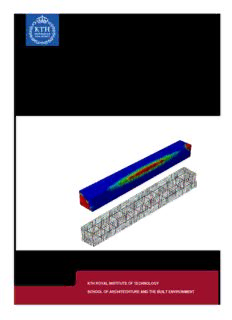
Second-order FE Analysis of Axial Loaded Concrete Members According to Eurocode 2 PDF
Preview Second-order FE Analysis of Axial Loaded Concrete Members According to Eurocode 2
DEGREE PROJECT IN CONCRETE STRUCTURES , SECOND LEVEL STOCKHOLM, SWEDEN 2015 Second-order FE Analysis of Axial Loaded Concrete Members According to Eurocode 2 NESSA YOSEF NEZHAD ARYA KTH ROYAL INSTITUTE OF TECHNOLOGY SCHOOL OF ARCHITECHTURE AND THE BUILT ENVIRONMENT Second-order FE Analysis of Axial Loaded Concrete Members According to Eurocode 2 Nessa Yosef Nezhad Arya June 2015 TRITA-BKN. Master Thesis 466, Concrete Structures, 2015 ISSN 1103-4297 ISRN KTH/BKN/EX--466--SE Royal Institute of Technology (KTH) Department of Civil and Architectural Engineering Division of Concrete Structures Stockholm, Sweden, 2015 © Nessa Yosef Nezhad Arya 2015 Abstract A nonlinear finite element analysis was performed for an axial loaded reinforced concrete column subjected to biaxial bending taking into account second-order effects. According to Eurocode there are two ways to take second-order effects into consideration: nonlinear FE analysis and hand calculation based on the simplified methods explained in Eurocode 2. Since simulating this kind of structures in ABAQUS is difficult, several simulations were made to find the correct model with satisfying accuracy. The nonlinear analysis focused on material modelling of concrete and its nonlinear behaviour. The simulation took into consideration the inelastic behaviour of concrete along with the confinement effect from transverse reinforcement. The finite element model was verified by comparing the obtained results from FEA to the results from a benchmark experiment. The mean values needed for simulating the FE model was derived from the mean compressive strength of concrete. After verification, another FE model using design parameters was analysed and the results were compared to the results from calculations based on simplified methods according to Eurocode 2 to see how much they agreed with each other. In a parametric study, the effect of eccentricity, compressive and tensile strength of concrete, fracture energy, modulus of elasticity, column cross- section dimension and length, steel yield stress and stirrup spacing were studied. A comparison between outcomes from the simplified methods and ABAQUS, calculated with design parameters showed that the bearing capacity from FE analysis was 21-34 % higher than the one obtained with the simplified methods. It is recommended that in further studies, analyse different slender reinforced concrete column with different L/h with FE- simulation to investigate if FEA always gives a more accurate result. For this case, and probably for columns with complex geometries, a finite element analysis is a better choice. Keyword: Second-order, nonlinear, slender reinforced concrete column, ABAQUS, FE analysis, curvature method, nominal stiffness method, eccentrically loaded, benchmark experiment, parametric study. iii Sammanfattning En icke-linjär finitelementanalys för en armerad betongpelare utsatt för tvåaxlig böjning genomfördes med hänsyn till andra ordningens effekter. Enligt Eurokoder finns det två sätt att iaktta andra ordningens effekter: icke-linjär analys och handberäkning baserad på de förenklade metoderna förklarad i Eurokod 2. Eftersom det är svårt att simulera den här typen av konstruktioner i ABAQUS, så har flera simuleringar utgjorts för att finna ett modell med acceptabelt noggrannhet. Den icke-linjära analysen fokuserade på korrekt materialmodell av betong och dess icke- linjära beteende. Modellen tog hänsyn till betongens oelastiska beteenden och inkluderade fleraxiella effekten. Finitelementmodellen verifierades genom att jämföra de erhållna resultaten från FEA till resultaten från ett försök. Värden som behövdes för att simulera FE-modellen härleddes från betongens medeltryckhållfasthet. Efter att referensmodellen var verifierad, ytterligare en FE-modell, som inkluderade designparametrar, analyserades och resultaten jämfördes med resultaten från beräkningar baserade på förenklade metoderna enligt Eurokod 2 för att se hur mycket de stämde överens med varandra. I en parameterstudie har effekten av excentricitet, tryck- och draghållfasthet av betong, brottenergi, elasticitetsmodul, pelarens tvärsnittsdimension och längd, stålsträckgränsen och centrumavstånd på byglar studerat. En jämförelse mellan resultaten från de förenklade metoderna och ABAQUS, beräknade med designparametrar visade att bärighetförmågan från FE-analys var 21-34% högre än den som erhålls med de förenklade metoderna. Det rekommenderas att i fortsatta studier, analysera flera slanka armerade betongpelare med olika L/h med FE-simulering för att undersöka om FEA alltid ger ett nogrannare resultat. För denna studie, och förmodligen för pelare med komplexa geometrier, är en FE-analys ett bättre val. Nyckelord: Andra ordningens effekt, icke-linjär, slank armerad betongpelare, ABAQUS, FE-modellering, krökningsmetoden, styvhetsmetoden, excentrisk last, utvärderingsförsök, parameterstudie v Preface and acknowledgements This study was carried out during spring semester and was submitted to the Division of Concrete Structures at School of Architecture and the Build Environment at KTH Royal Institute of Technology for the degree of Master of Science in Civil Engineering. My thanks and appreciation go to my supervisor Håkan Hansson who has supported me with patience and good advices throughout the entire period of this work. A special gratitude goes to Tobias Gasch for providing excellent guidance and knowledge about ABAQUS and answering all my questions about this software. My gratitude also goes to my examiner Professor Anders Ansell who gave valuable lectures throughout the master program and helped me find the subject for this master thesis. I would like to thank my colleagues at Bjerking AB for encouraging me with their best wishes. Stockholm, June 2015 Nessa Yosef Nezhad Arya vii
Description: